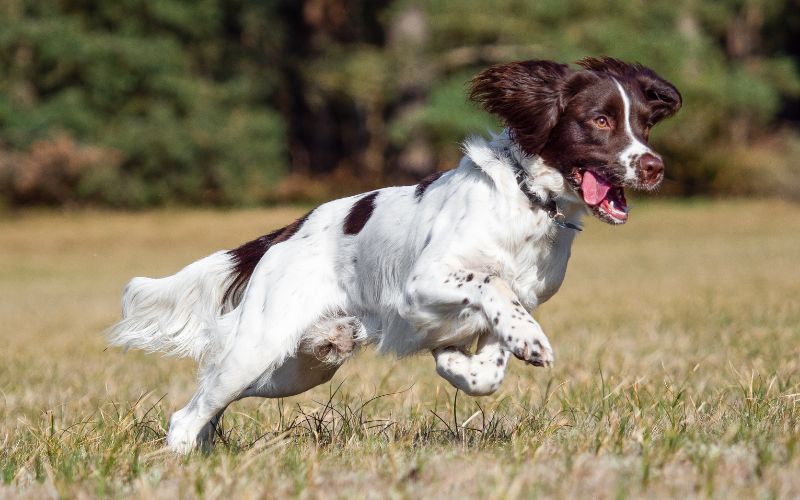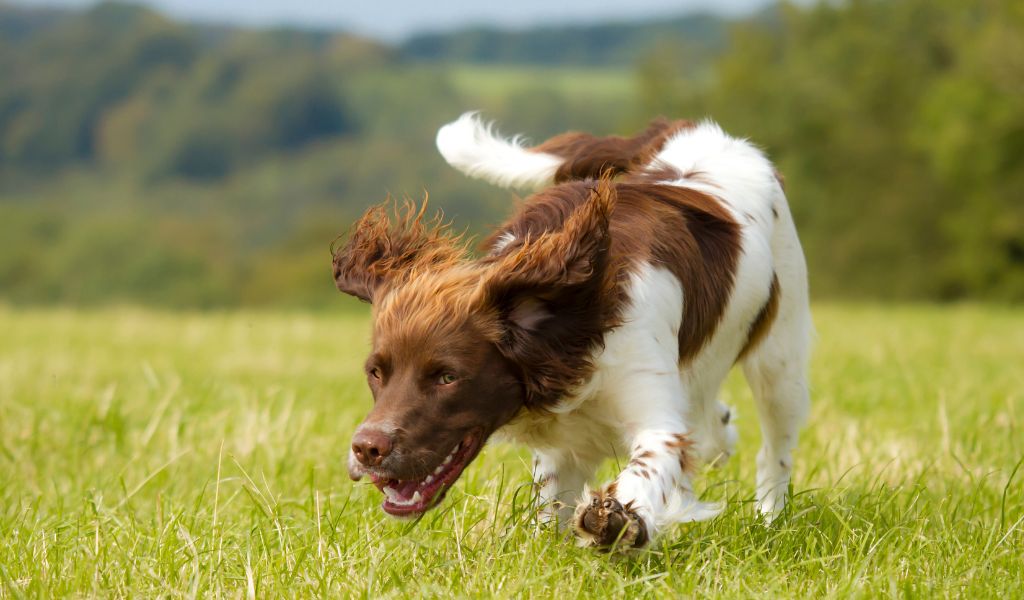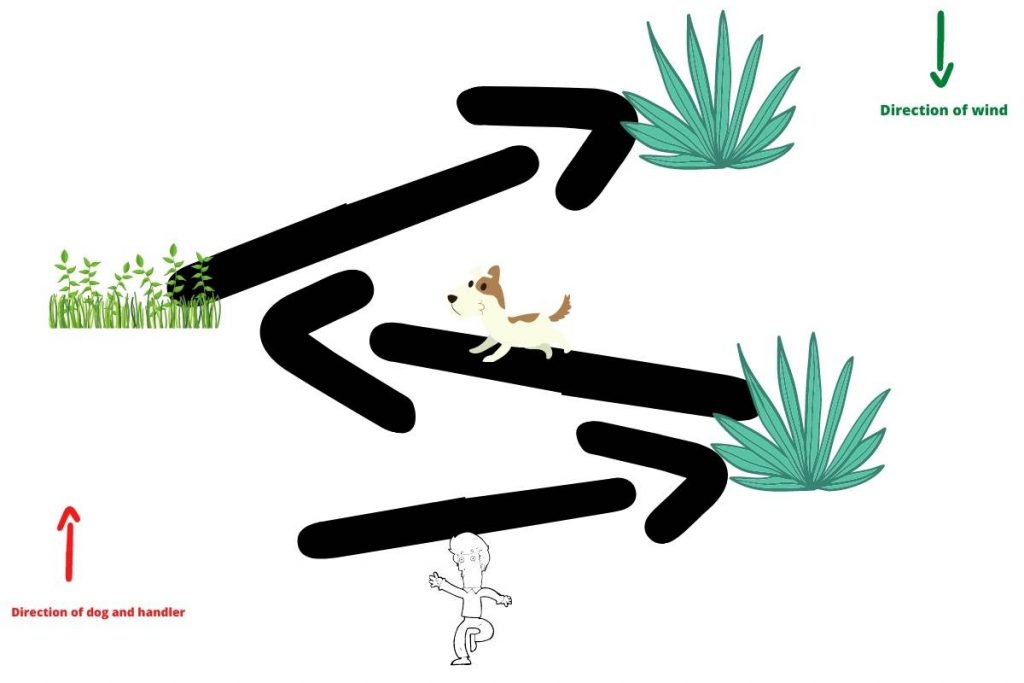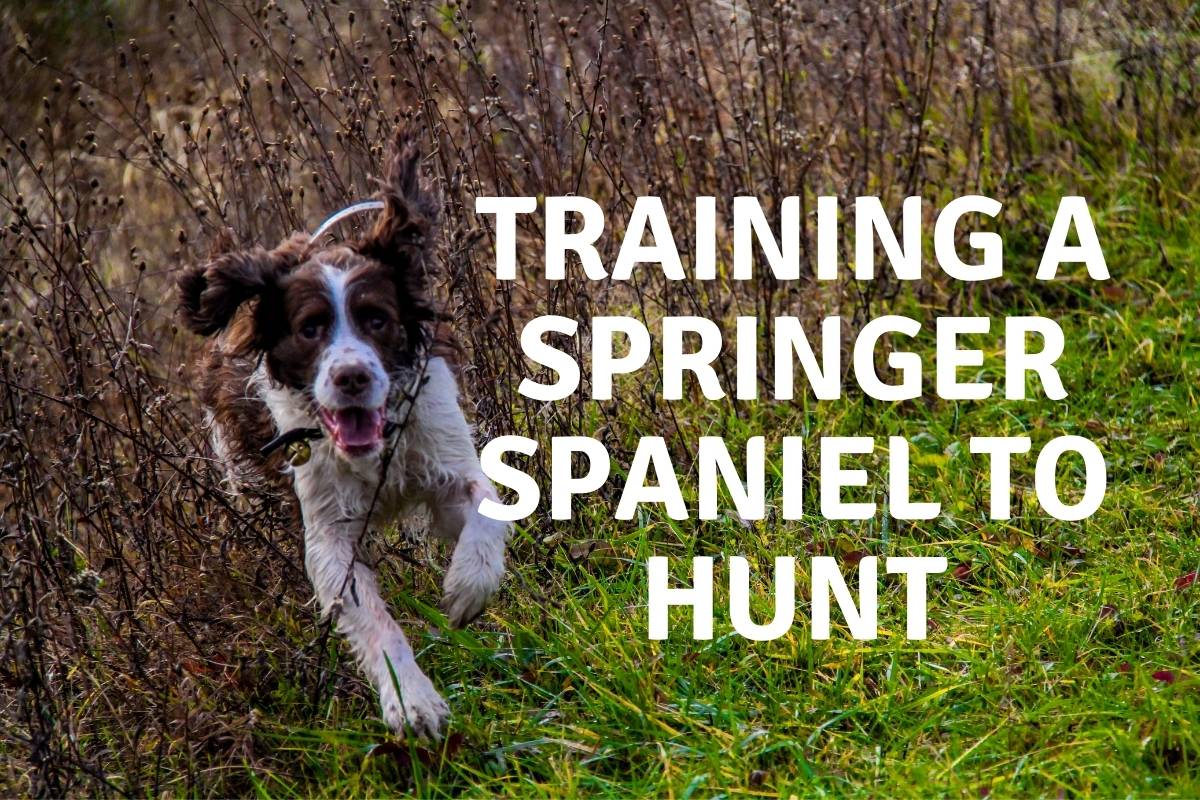Springer spaniels are excellent working dogs, full of energy, keen to learn and very amenable to training.
As a gun dog the Springer is arguably one of the best all rounders, a powerful and capable hunter and a good, keen retriever both on land and in water.
Training a Springer spaniel to hunt effectively is an important exercise that will take up the majority of your Springer training. Thankfully it is an enjoyable and easy activity to undertake providing that you follow a few basic principles and pay close attention to your dog when out hunting. Springer spaniels are natural hunters and this is one aspect of spaniel training that you should have little difficulty with.
Are Springer spaniels good hunting dogs?
Springer spaniels are well recognised as being excellent hunting dogs, and, having trained and worked several Springers, I am able to vouch for their ability when hunting game, both birds and land based game such as rabbits.
This breed of spaniel has an excellent nose and scenting ability which, with exposure to game through effective training, makes it one of the the best of the spaniel breeds for walked up and driven game shooting.
Springers have almost infinite levels of drive and energy and a fit Springer spaniel is easily able to maintain his performance during the course of a busy day’s hunting and shooting.
Why we train a Springer spaniel to hunt
Springers, like all spaniels, are natural hunters and are capable of hunting all on their own.
As owners and handlers we don’t really train a Springer to hunt but, we train a Springer to hunt effectively, in a way that suits our needs for shooting and other purposes.
The way that we train a Springer spaniel to hunt involves exposing him to a variety of different situations that will help him to recognise the smell of game, use the wind effectively and stay within range without getting too far away.
Just as the police or customs would teach a spaniel to recognise the smell of drugs or explosives, as a gundog we look for ways to introduce our Springers to the scent of various types of game to improve his hunting ability.
A good customs Springer finds illegal substances and a good working Springer, used for hunting, will find copious quantities of game if he is trained to hunt properly.

A few considerations when training a Springer spaniel to hunt
Whenever you embark on any form of training with your spaniel ( or for that matter any dog ), there are always a few things that you will need to consider:
The area
Where are you going to do the training?
You’ll need to find somewhere quiet, where there are no distractions, such as other dogs, people and too much game or wildlife.
The weather
You should never hunt your spaniel in the heat of the day.
In summer temperatures can be excessive and, for a dog that is running and hunting, he can quickly become overheated, dehydrated and working in hot conditions will encourage your dog to slow down and pace himself.
Avoid hunting and other high pace training on hot days and have a day off or do some water work.
The type of ground
When you are training a Springer or other spaniel breed to hunt then, in the early days, you need to think about the type of cover.
Cover that is tough such as brambles or sharp such as dead bracken, can be off putting for a young spaniel or a dog that is new to hunting.
The best cover for a novice spaniel is rushes of the type often found on open moorland.
Rushes are soft yet provide interesting cover that holds scent well. They are also found in clumps which can you to introduce a pattern to your spaniel’s work.
Extremes of weather
Hot days have already been mentioned but the same can be said for other types of weather extremes.
Storms, heavy rain and snow can all impact the ability of a young spaniel and can be off putting.
If the weather is awful then hold off with the hunting, it won’t do you or the dog any harm to wait until it improves.
As your Springer becomes more experienced and competent with his hunting you will be able to introduce him to different types of cover, different environments and also be able to take him out working in different weather conditions.

Basic hunting training with a Springer spaniel
Try to pick a calm day when the ground is slightly damp and any breeze is slight.
Ideally you’ll be in an area where there are rushes or other ‘clumps’ of light cover that your spaniel can move between.
Take your spaniel, on his lead, to the area that you plan to hunt through.
Make sure that you are facing into the wind. This is very important with a young spaniel or with a spaniel that has never done any hunting training.
Don’t be lazy with this, always hunt a young or inexperienced Springer into the wind.
Sit your dog down,
Calmly take his lead off and tell him to stay.
When you are ready, cast your dog off to one side ( left or right ) with the command ‘Get On’ and indicate with your hand the direction that you want him to go in and you should begin to walk slowly in that direction.
As your Springer heads off, wait until he is about 15 to 20 yards beyond you and then give two quick, short peeps on your whistle, get his attention and then turn and walk in the other direction.
This is where cover such as rushes help – when you turn your dog try to get him towards a patch of interesting cover that he can run towards and explore.
The diagram below should give you an idea of this.
Training a Springer spaniel to hunt

As you can see from above you are aiming to get your Springer to cover the ground ahead of you, exploring all of the cover that he encounters, and turning him so that he does not get too far out to either side.
The distance varies among trainers, with many keeping their spaniels really close and others letting their dogs hunt further out.
You should aim to keep your Springer around 25 to 30 yards away, no further – this distance is around the effective range of a shotgun – imagine that you are walking up game with your spaniel.
Be prepared to walk in a zig zag like fashion during the early days of your training, this will encourage your spaniel to cover the ground properly.
As he becomes more proficient you will be able to walk in a straight line as he ‘quarters’ the ground ahead of you.
Top tip
A useful skill – that can set you above many other spaniel handlers, is to be able to direct your spaniel to an interesting piece of cover simply with your body position.
As your dog develops his skill he will keep an eye on your position, as you are hunting with him, turn your body slightly and look and nod towards an area of interesting cover – chances are he’ll change direction and take a look.
This takes practice but it’s great when it works and it’s added polish which will help you in competitions.
Keep your hand signals to a minimum when hunting
One thing to note – you’ll often see spaniel handlers indicating with their hands for their dog to quarter and many of them can look like a windmill when they are hunting their Springers.
Try to avoid doing this – in the early stages you may need to use an extended arm to encourage your dog to change direction but, as he develops his skill, drop the hand signals when hunting.
If you use too many hand signals when you are hunting your Springer will get ‘sticky’, he’ll often stop to watch you and you want to avoid this.
Get a coat with pockets and put your hands in them when you are hunting with your Springer. Only give hand signals when hunting if they are absolutely necessary.
When to start hunting training with a Springer spaniel
Most spaniels, Springers included enjoy hunting so much that they can ‘neglect’ other areas of their training and so it is important to focus more on the other areas before getting heavily active with hunting work.
The most common problem with Springers is that they can almost refuse to retrieve if they have been allowed to hunt too much as youngsters.
Your Springer should be a reasonable retriever of the dummy or ball before you spend time focussing on hunting and your early training days should focus upon basic skills including retrieving.
Once your Springer spaniel has begun to mature and reaches 6 to 8 months old you can begin to work on training him to hunt.
A word on the schedule. When you are training your dog to hunt, it is always best to do some retriever training before you set him off hunting. This will help to embed the retrieving and the hunting work will be a ‘reward’ for retrieving.
More advanced Springer spaniel hunting training
As your Springer becomes more conversant with hunting you will need to adapt his style to help him to use the wind.
I’ll cover these different aspects of hunting with different wind patterns in another article, but in essence your dog should always be working in a manner that gets his nose into the wind.
You can read more about working with your spaniel’s sense of smell in this article.
As you are hunting your Springer, stop him occasionally with the stop whistle, and throw a dummy into cover. When you are ready send your dog for the retrieve using the fetch command.
Make this exercise more challenging by dropping a dummy without your dog seeing it, then whistle him to stop and send him for the blind retrieve.
As he becomes more experienced you can use the starting pistol, firing a shot to stop him and then sending him for a retrieve.
This is, in effect, joining all of the dots together in the training of your spaniel, you can even use cold game for the retrieving.
Final Words
Training a Springer spaniel to hunt is great fun and, once your dog is good at the basics of sitting and retrieving, you’ll find that hunting is the main activity that you will work on.
As your dog progresses you can make hunting to be a challenging task and with some thought will be able to create scenarios that resemble real life shooting conditions to help your spaniel to learn and grow in confidence and ability.




